TYING DRY FLIES WITH DRY CELL FOAM
BRITISH FLY FAIR
INTERNATIONAL
2009
Big Screen Presentation
By: Tom Travis, USA
TYING DRY FLIES WITH
DRY CELL FOAM
I have encountered many fly tiers that have an aversion to materials that are not natural. Both in the United Kingdom and United States, I have heard fly tier’s say: “Well, Bergman didn’t have any of that”, or “Halford would never have used something like that!”, and so on and so forth.
Well guess what? All of the creative and innovative fly tiers, who have gone before us, once they understood the properties of the new synthetic materials would jump at the chance to use them. However, I also believe that this sort of discussion is somewhat pointless, as all we can really do is speculate on what they MIGHT have done. The fact is that we have many fine modern synthetic materials, including various types of Dry (closed cell) and Wet (open cell) Foam. These various types of foam can help us achieve many effective imitations. Thus, we come to the focus of this presentation: Tying dry flies with dry closed cell foam.
Dry cell foam may be found in many different guises; it can be in sheet form of various thicknesses, blocks, and cylinders and even in tiny ball and various strips. Foam may also be found in a multitude of different densities. Some foam is very hard and dense, while other types are much softer and more flexible.
Besides the Fly Tying Supply House, you can also find a wide variety of dry cell foam at craft shops, toy stores, dollar stores and Wal-Mart type stores. I have even found dry cell foam in clothing stores and at the super market.
However, it isn’t where you find it; it’s what you do with it as fly tying material that makes dry cell foam of interested to the angler/tiers of today. There are several patterns that can be primarily tied using nothing but thread, dry cell foam, and rubber legs. However, for many effective patterns dry cell foam is only one of the components of the pattern. Dry cell foam can add float-a-bility, visibility and allow you to design patterns that sit on and in the water in a more natural manner. Remember, when designing a pattern, the hook style chosen for the imitation is as important as the materials. Now, we will look at list of possible pattern types that may be constructed with various forms of dry cell foam.
Emerging Midge Pupa Midge Adults Midge Cripples
Floating Nymphs (Mayflies) Para-Emerging Nymphs Parachute Duns Spinners
Caddis Emergers Caddis Adults Caddis Cripples
Note: Back in the 1980’s, long before dry cell foam was hardly known of, a very innovative and creative fly tier by the name of Roman Moser was using it on Caddis imitations.
Adult Stone Flies
All manner of terrestrials can be tied with dry cell foam.
Grass Hoppers Crickets Beetles Ants Bees Spiders Caterpillars
Adult Dragon Flies Adult Damsel Flies
Attractor Patterns like the famous Chernobyl Ant
Floating Minnow Poppers Sliders
I’ll bet you are wondering what kind of special tools are needed to use dry cell foam. Very few! Razor Blades, sharp scissors, a good straight edge and that’s about all.
If you delve into popper and sliders and other similar patterns, you will need a cordless Dremel tool and a paper cutter.
Now, what can you do with dry cell foam? You can make extended bodies using single or multiple colors. You can make twisted bodies; you can use it as a wing post, bullet head, and wing case, lips on a diving pattern or popper. You can color it with permanent markers, you can slightly heat it to taper and tip. You can burn eye sockets, you can glue strip together. The only limits on how you use dry cell foam are limits you impose upon yourself.
HOWEVER, THERE IS ON IMPORTANT POINT TO REMEMBER WHEN USING DRY CELL FOAM. WHEN YOU STRETCH IT OR COMPRESS IT, YOU ARE INTERRUPTING THE INTEGRITY OF THE CLOSED CELL, WHICH GIVES THE FOAM IT’S FLOAT-A-BILITY.
When using foam as the main material on a beetle or hopper imitation this is not a factor. But when using dry cell foam for a wing case, don’t stretch it! Simply fold it!
Now, for some patterns using dry cell foam. I am going to list just a few basic patterns using dry cell fly foam. You are only limited by your own willingness to experiment!
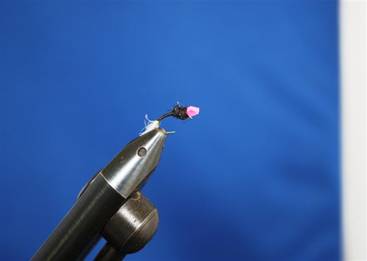
MIDGE IMITATIONS
Emerging Midge Pupa, Black
- Hook: Tiemco 100 or TMC 2487
- Sizes: 14-24 or to Match the size of the natural
- Thread: 12/0 or 8/0 Black
- Abdomen: Black Thread tapered, with Brown thread rib
- Foam Post: A strip or cylinder section of Dry Cell Fly Foam,
I use white; however, some prefer yellow or orange - Thorax: Dubbed, Black Rabbit Fur
Notes: This is just the basic pattern style, the colors used and the materials used in construction are to are to numerous to list.
By Adding Parachute hackle to the base of the Foam Post, now you have a Parachute Emerging Midge.
Crippled Midge Adult, Gray
- Hook: TMC 101
- Sizes 14-24
- Thread: 12/0 or 8/0 Gray
- Shuck: Grizzly Hackle Tip (Dry Fly)
- Shellback: 1 mm strip of Dry Cell Foam
- Abdomen: Dubbed, Gray Muskrat Fur or Beaver
- Hackle: Grizzly, palmered through the thorax onlY
- Thorax: Dubbed, Gray Muskrat or Beaver
MAYFLY IMITATIONS
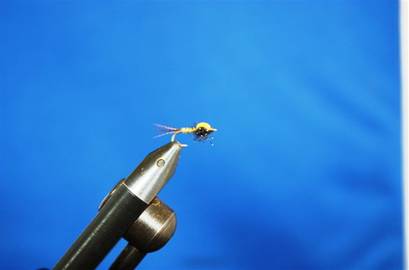
Foam Floating Nymph, Pale Morning Dun
- Hook: TMC 101
- Sizes: 14-20 or to match the naturals
- Thread: 12/0 or 8/0 Lite Dun or Rusty Dun
- Tails: Natural Wood-duck Flank Fibers
- Abdomen: Turkey Biot dyed BWO
- Wingcase: Gray Dry Cell Fly Foam
- Thorax: Dubbed, Scintilla #15 Pale Yellowy Olive
Note: This style can be used to imitate and any mayfly which hatch from the surface of the water. Just change the colors and sizes to match the naturals. You could also construct the pattern on a TMC 2487, thus slightly changing the configuration of the pattern, and how it appears on the surface of the water. You could also employ parachute hackle around the base of the wing case.
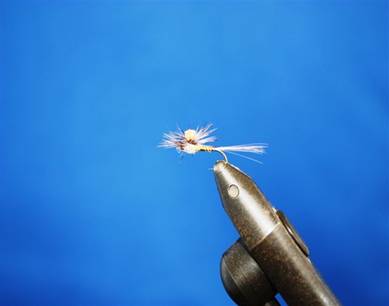
Foam Parachute Spinner, PMD
- Hook: TMC 101
- Sizes: 14-20
- Thread: 12/0 Lite Dun or Rusty Dun
- Tails: Lite Dun dry fly hackle fibers, tied long
- Abdomen: Turkey Biot dyed PMD
- Wingpost: Dry Cell Foam, color as desired
- Hackle: Lite Dun, tied parachute style
- Thorax: Dubbed, Scintilla #15 Pale Yellowy Olive
CADDIS IMITATIONS
Foam Emerging Caddis Pupa, Black & Olive
- Hook: TMC 2487
- Sizes: 14-22
- Thread: 12/0 or 8/0
- Abdomen: Olive antron fibers, twisted and wrapped
- Post: Olive or Yellow Dry Cell foam
- Thorax: Dubbed, Black Rabbit fur,
- Hackle: Starling Back Feather,
Foam Caddis Cripple, Olive and Black
- Hook: TMC 101
- Sizes: 12-22 or to match Natural
- Thread: 12/0 or 8/0 Olive Dun
- Shuck: Tan antron fibers
- Body: Dubbed, Olive Beaver
- Foam Head: Strip of Black Dry Cell Foam
- Hackle: Black, palmered through the thorax,
clipped top & bottom - Thorax: Dubbed, Black Beaver
TERRESTRIAL IMITATIONS
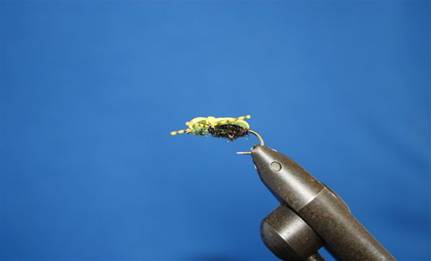
Black Foam Beetle
- Hook: TMC 101
- Sizes: 10-22
- Thread: 6/0, 8/0 or 12/0 Black
- Back Shell: Strip of Dry Cell Foam; I use Orange, Yellow, Hot
Green, Pink, because I can see them, I use a Sharpie
Marker to color the edges to make sure that the trout
does not see the bright colors. Then I have some fun
by drawing a Smiley Face on the Back of the Beetle!! - Body: Dubbed, Peacock UV Dubbing
- Legs: Black Rubbed Legs, two per side
- Front Shell: Strip of Black Dry Cell Foam
- Head: Dubbed, Black Beaver Fur
- Indicator: Bright colored dry cell foam (because I use bright foam on the back I no longer add an indicator.
However, if you use black, brown or dark green dry cell foam you may wish to add the Indicator for visibility.
Note: There is over six thousand species of beetles in the United Kingdom. The U.S. has of Nineteen Thousand species of Beetles. The trout see them on water throughout the summer, we as angler only notice the when there is an infestation or during specific time with specific species. Beetles can be an excellent pattern to use on a warm summer afternoon when the hatches are over.
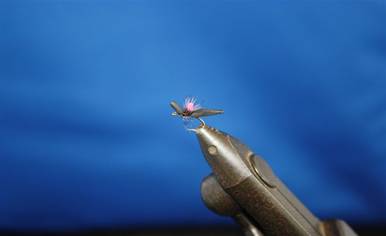
Black Foam Ant, with Legs
- Hook: TMC 101
- Thread: 12/0 or 8/0 Black
- Sizes: 10-20
- Abdomen: Black dry cell fly foam
- Legs: Two per side, Black, rubber
- Waist: Black thread
- Hackle: Black, dry fly, wrapped, undersized, clipped off the bottom
- Thorax: Black, dry cell fly foam
Note: This ant can be tied in many different and effective color variations.
[No legs on the illustration – forgot to bring the material to my demonstration]
Note: There are thousands of dry flies and emergers that can be tied with dry cell fly foam. Go on, create, and try something new and different.
If you have any further questions about constructing imitations with dry cell fly foam, you may contact me at Ttravis@MCN.Net .
Enjoy & Good Tyin’
Tom
Note:
This was a presentation I gave in the Fly Tying Theatre at the BFFI 2009, not all of the patterns listed were tied and photographed. I might have even strayed a little with colors, but the results are still the same.
